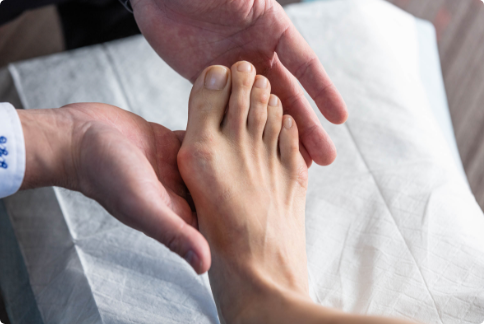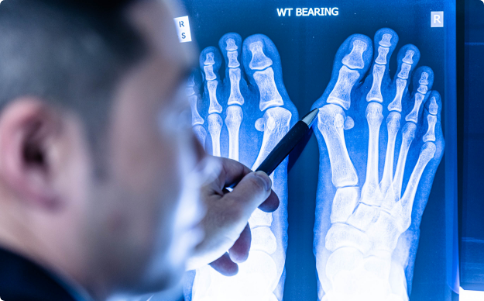Bunions Treatments
What is a Bunion?
A bunion is a painful bony bump that develops on the inside of the foot at the big toe joint. This conditions medically is known as “Hallux Valgus” and is the result of the big toe (hallux) angling towards the outside of the foot (Valgus). Shoe wear often exerts pressure on the bunion resulting in inflammation and pain making daily activities difficult.
What happens to Bunions if left untreated?
Unfortunately, bunion deformities tend to progress and get worse with time. As the deformity progresses other joints and toes may be affected occasionally resulting in adjacent pain and arthritis.
What are the non-operative treatments for Bunions?

What are the surgical treatments for Bunions?
Surgery is considered for patients with persistent pain despite all attempts at non-operative treatment. The goal of surgery is to correct the deformity, relieve the associated pain, restore the anatomical alignment of the great toe and prevent re-occurrence.
Every bunion is different, and a detailed pre-operative assessment by Dr. Chow will ensure the appropriate operation can be tailored to the individual patient. Various procedures are offered to address these factors and Dr. Chow will offer you the best procedure to fit the needs of your foot.
Bunion Surgery may involve;
- Swelling.
- Pain and Tenderness around the Big toe and Bunion.
- Difficulty with shoe wear especially with activity and often relieved in bear feet.
- Change in the shape of the foot and big toe.
Book an Appointment Today!

Will the Bunion return after surgery?
There is always a potential for the surgically corrected bunion to recur even when the procedure is performed correctly. The reported literature states a recurrence rate post bunion surgery of 2.7-16%.
What to expect after Bunion surgery?
You should expect to stay 1-2 days in hospital with your leg elevated. This will allow for adequate pain control and a thorough physiotherapy assessment. Depending on the operation performed on your foot the weight bearing status may vary and a post-operative boot or shoe will be required. You will also be started on blood thinners to prevent clots for a 6 week duration.
Dressing should remain dry and intact until the first post-operative appointment. Your sutures will be removed after 2 weeks and scar massage desensitization and early ROM will commence with a physiotherapist. A repeat x-ray will be undertaken at 6 weeks and at that time immobilization may be ceased to transition into a normal roomy shoe.
Expect at-least 3 months before commencement of light exercise up to 6 months for full recovery and swelling to resolve.
Potential complications of Bunion surgery
All surgical procedures involve inherent risk of complications. However, these risks are generally uncommon and quite infrequent. These include anesthetic complications, wound infections, nerve injuries, tendon injuries, bleeding, fracture, failure of bone to heal, ongoing pain, stiffness, chronic regional pain syndrome, blood clots and recurrence of the deformity.
Patients can minimize the risk of complications by carefully following post-operative instructions.
